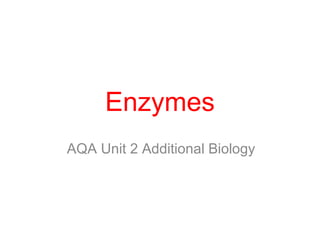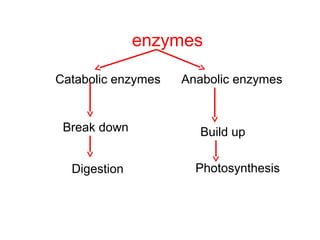B2.5 proteins enzymes
- 1. Enzymes AQA Unit 2 Additional Biology
- 2. Proteins have many functions, both inside and outside the cells of living organisms. Proteins, as enzymes, are now used widely in the home and in industry. B2.5 Proteins – their functions and uses You should be able to: ■ evaluate the advantages and disadvantages of using enzymes in the home and in industry.
- 4. ENDOCRINE SYSTEM Pituitary Thickens womb wall Insulin Oral contraceptive Travels in e.g.e.g. e.g . e.g . controls secretes used in consists of secrete are inhibits secretes. has less Bloodstream Blood sugar Chemical messengers FSH Glands LH Hormones Oestrogen Ovary Matures egg Pancreas Progesterone Releases egg Side effects
- 5. ENDOCRINE SYSTEM Glands Bloodstream Hormones Matures egg LH Oestrogen FSH OvaryPituitary Thickens womb wall Releases egg Insulin Pancreas Oral contraceptive Side effects Progesterone Travels in e.g.e.g. e.g . e.g . Blood sugar controls. secretes. used in consists of secrete Chemical messengers are inhibits secretes. has less
- 6. Proteins Structural tissues eg muscles Antibodies Hormones Enzymes Amino acids – about 20 different types
- 7. What are enzymes and what do they do? Enzymes are- • Protein molecules (made up of amino acids) • Biological catalysts (Increase the speed of chemical reactions) • Specific (Each one catalyses one particular reaction) • Reusable (Can be used again and again) • Affected by temperature and pH. • Found in animals, plants and microorganisms.
- 9. 2 main types of enzymes • Catabolic enzymes which (break down) large molecules into smaller molecules e.g. digestion of starch by the enzyme amylase into glucose. • Anabolic enzymes which (build up) small molecules to form larger molecules e.g. production of glucose during photosynthesis from carbon dioxide, water and light.
- 10. Catabolic enzymes Anabolic enzymes enzymes Break down Build up Digestion Photosynthesis
- 11. Enzymes and activation energy • Chemical reactions take place when particles collide with enough energy. • The minimum amount of energy required is called the activation energy. • Enzymes lower the amount of activation energy required, so the reaction can proceed at a greater rate.
- 12. • Enzymes are proteins made up on long chains of amino acids. • These long chains fold to produce a special shape which is vital for the enzyme’s function. Active Site Structure of an enzyme molecule
- 13. How enzymes work
- 14. Step-by-step • Shape of the enzyme’s active site is complimentary to the shape of one particular substrate. • The two bind together to form an enzyme- substrate complex. • The reaction between them take place rapidly. • The products are released from the enzyme’s active site. Complete Qu 1-8 page 12.
- 15. Enzymes 1. Enzymes ………….. up the rate of chemical ………………….. 2. Enzymes are ………………….. because they only work on one substrate. 3. The substrate fits into the ………………….. site of the surface of the …………………... 4. With an increase in ………………….. the rate of reaction ………………….. 5. Enzymes can be re-used, so only ………………….. amounts are needed. 6. To which group of chemical compounds do enzymes belong? 7. Why is an enzyme specific for a particular substrate? 8. Why can an enzyme be used again and again?
- 16. Factors affecting enzyme action - Temperature • Enzymes work faster as the temperature increases up to 40o C, but are eventually denatured at about 60o C. • This is because the shape of the active site is lost.
- 17. Factors affecting enzyme action – pH • Each enzyme works best at a particular pH. This is known as the optimum pH. • Extremes of pH will cause the active site to denature.
- 18. 11. A number of factors can alter the rate of an enzyme- controlled reaction. Say what each of the following would do to the rate of reaction and give your reasons. An increase in enzyme concentration …………………..…………………..…………………..………………….. …………………..…………………..…………………..………………….. A decrease in temperature …………………..…………………..…………………..………………….. …………………..…………………..…………………..………………….. A lowering of pH …………………..…………………..…………………..………………….. …………………..…………………..…………………..…………………..
- 19. Enzymes in digestion • Enzymes break down large insoluble food molecules into smaller, soluble ones which can be absorbed through the small intestine wall to enter the bloodstream. • Different parts of the digestive tract have different pH conditions to enable different enzymes to work.
- 20. The main groups of digestive enzymes • Lipase enzymes digest fatty substrates. • Protease enzymes digest protein substrates. • Carbohydrase enzymes digest carbohydrate substrates.
- 21. Substrate Enzyme Product Where enzyme produced Optimum pH Starch Amylase (a carbohydrase) Glucose Salivary glands & pancreas pH7 Protein Trypsin (a protease) Amino acids Stomach, pancreas, & small intestine pH3 Lipids Lipases (fats) Fatty acids & glycerol Pancreas pH8
- 22. The action of bile • It’s produced by the liver and is stored in the gall bladder which, squirts it into the small intestine. • It’s alkaline to neutralise acidic chyme coming from stomach. • It emulsifies fats to break them into smaller droplets which increases the surface area for lipase enzymes to work.
- 23. Lipase is an enzyme that breaks down fats. We can use an indicator to follow this reaction. The indicator is red to start with but turns yellow when all the fat has been broken down. Look at the results table below. Test-tube Temp (°C) Original colour Final colour 1 0 Red Red 2 10 Red Orange 3 40 Red Yellow 4 60 Red Orange 5 100 Red Red What is the optimum temperature for lipase? ………………….. Why do you think the colour didn’t change in test tube 1? …………………..…………………..…………………..………………….. Why do you think the colour didn’t change in test tube 5? …………………..…………………..…………………..………………….. Predict what you think would happen if you warmed test tubes 1 and 5 up to 40 °C. Try to explain your prediction.
- 24. 13 Which enzymes work on carbohydrates? ………………….. 14. Which enzymes work on proteins? ………………….. 15.Which enzymes work on fats? ………………….. Name the products which are formed in each case. …………………..…………………..…………………..………………….. ………………………………..…………………..………………….. …………………..…………… Name 3 functions of bile …………………..…………………..………………….. …………………..…………………..………………………..………………….. …………………..………………….. …………………..…………………..…………………..…………………..……………
- 25. i) Some microorganisms produce enzymes that pass out of the cells. These enzymes have many uses in the home and in industry. In the home: ■ biological detergents may contain protein- digesting and fat-digesting enzymes (proteases and lipases) ■ biological detergents are more effective at low temperatures than other types of detergents.
- 26. Advantages Disadvantages These are more efficient at removing stains from clothes. If the clothes are not fully rinsed, protease enzymes may remain in the clothes, which digests protein in the skin. Lower washing temperatures can be used which saves energy. This can lead to irritation, allergies and dermatitis.
- 27. In industry: ■ proteases are used to ‘pre-digest’ the protein in some baby foods This reduces how much the baby needs to digest the food ■ carbohydrases are used to convert starch into sugar syrup This is cheaper than extracting sugar from sugar cane ■ isomerase is used to convert glucose syrup into fructose syrup, which is much sweeter and therefore can be used in smaller quantities in slimming foods.
- 28. Advantages Disadvantages Enzymes enable industrial reactions to take place at lower temperatures. Enzymes are sensitive to temperature and pH changes. Supplying heat is expensive. When enzymes are used, industrial processes can be cheaper. Temperature and pH need to be carefully monitored and controlled, which can be expensive. j) In industry, enzymes are used to bring about reactions at normal temperatures and pressures that would otherwise require expensive, energy-demanding equipment. However, most enzymes are denatured at high temperatures and many are costly to produce.
- 29. Commercial use of enzymes Product Enzymes Explanation Biological washing powder Lipases and proteases Digest biological stains off clothes. Baby food Proteases Pre-digest protein to make digestion easier for babies. Slimming foods Isomerase (carbohydrase) Converts glucose into fructose (less of which is needed to sweeten food).
- 30. In 1989 a new fat digesting enzyme was found in a fungus. Its optimum pH is 7.5. It can act at low temperatures and after a few days, breaks down into carbon dioxide, nitrogen and water. Give 2 reasons why this enzyme is now used in washing powder …………………..…………………..…………………..…………………..……………. …………………..…………………..…………………..…………………..……………… Why would a washing powder of high pH or low pH be difficult to handle? …………………..…………………..…………………..…………………..……………… …………………..…………………..…………………..…………………..………………
- 31. Complete the diagram below to show how the three main food groups are broken down during digestion. Amylase Amino acids Fat Fatty acids Glycerol Maltose Protease Protein Lipase Protease Amino acids Fat Glycerol Fatty acid
- 32. Complete the diagram below to show how the three main food groups are broken down during digestion. Amylase Amino acids Fat Fatty acids Glycerol Maltose Protease Protein Carbohydrate eg starch Amylase Maltose


































